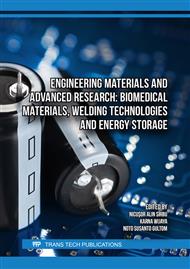[1]
N. Nitta, F. Wu, J. T. Lee, G. Yushin, Li-ion battery materials: Present and future, Materials Today 18 (5) (2014) 252–264.
DOI: 10.1016/j.mattod.2014.10.040
Google Scholar
[2]
A. Manthiram, Y. Fu, Y. Su, Challenges and prospects of lithium-sulfur batteries, Acc. Chem. 46 (5) (2013) 1125–1134.
DOI: 10.1021/ar300179v
Google Scholar
[3]
X. Ji, K. T. Lee, L. F. Nazar, A highly ordered nanostructured carbon-sulphur cathode for lithium-sulphur batteries, Nat. Mater. 8 (6) (2009) 500–506.
DOI: 10.1038/nmat2460
Google Scholar
[4]
M. Rana, S. A. Ahad, M. Li, B. Luo, L. Wang, I. Gentle, R. Knibbe, Review on areal capacities and long-term cycling performances of lithium sulfur battery at high sulfur loading, Energy Storage Materials 18 (2019) 289–310.
DOI: 10.1016/j.ensm.2018.12.024
Google Scholar
[5]
K. Yang, Q. Gao, Y. Tan, W. Tian, L. Zhu, C. Yang, Microporous carbon derived from Apricot shell as cathode material for lithium–sulfur battery. Microporous Mesoporous Mater. 204 (2014) 235–241.
DOI: 10.1016/j.micromeso.2014.12.003
Google Scholar
[6]
P. Liu, Y. Wang, J. Liu, Biomass-derived porous carbon materials for advanced lithium sulfur batteries. J. Energy Chem. 34 (2019) 171–185.
DOI: 10.1016/j.jechem.2018.10.005
Google Scholar
[7]
N. Jayaprakash, J. Shen, S. S. Moganty, A. Corona, L. A. Archer, Porous hollow carbon-sulfur composites for high-power lithium-sulfur batteries, Angewandte Chemie Int. ed. 50(26) (2011) 5904–5908.
DOI: 10.1002/anie.201100637
Google Scholar
[8]
G. Zeng, B. Zhou, L. Yi, H. Li, X. Hu, Y. Li, Green and facile fabrication of hierarchical N-doped porous carbon from water hyacinths for high performance lithium/sodium ion batteries. Sustain. Energy Fuels 2 (2017) 855–861.
DOI: 10.1039/c7se00517b
Google Scholar
[9]
M. Schnucklake, L. Eifert, J. Schneider, R. Zeis, C. Roth, Porous N- and S-doped carbon-carbon composite electrodes by soft-templating for redox flow batteries, Beilstein Journal of Nanotechnology 10 (2019) 1131–1139.
DOI: 10.3762/bjnano.10.113
Google Scholar
[10]
O. Nurhilal, R.S. Lesmana, K. Ramadayanti, S. Habibah, S. Hidayat, D. Sumiarsa, Risdiana, Synthesis of High Quality Porous Carbon from Water Hyacinth. Key Engineering Materials 860 (2020), 173–177.
DOI: 10.4028/www.scientific.net/kem.860.173
Google Scholar
[11]
S. Hidayat, S. Mudaim, O. Nurhilal, Risdiana, Study of Chemical Structure and Electrical Properties of Nitrogen-Doped Activated Carbon from Candlenut Shell (Aleurites moluccana), JIIF 06 (2020) 166 – 173.
DOI: 10.24198/jiif.v6i2.41015
Google Scholar
[12]
A. Manthiram, Y. Fu, S. Chung, C. Zu, Y. Su, Rechargeable Lithium−Sulfur Batteries. Chemical Reviews 114 (2014) 11751–11787.
DOI: 10.1021/cr500062v
Google Scholar
[13]
S. Mudaim, Synthesis and Characterization of Nitrogen-Doped Sulfur-Carbon Composite for Lithium-Sulfur Battery Electrode Material, Unversity of Padjadjaran, Bandung, 2022.
Google Scholar
[14]
S. Mudaim, S. Hidayat, Effect of Heating Temperature on the Chemical Structure and of Conductivity Carbon from Candlenut Shells (Aleurites moluccana ), JIIF 1028 (2021) 302–307.
DOI: 10.4028/www.scientific.net/msf.1028.302
Google Scholar
[15]
X. He, W. Pu, J. Ren, W. Li, J. Wang, C. Jiang, C. Wan, Charge/discharge characteristics of sulfur composite cathode materials in rechargeable lithium batteries, Electrochim. Acta 52 (25) (2007) 7372–7376.
DOI: 10.1016/j.electacta.2007.06.016
Google Scholar
[16]
J. Chen, J. Yang, G. Hu, X. Hu, Z. Li, S. Shen, M. Radosz, M. Fan, Enhanced CO2 Capture Capacity of Nitrogen-Doped Biomass-Derived Porous Carbons, ACS Sustain. Chem. Eng. 4(3) (2016) 1439–1445.
DOI: 10.1021/acssuschemeng.5b01425
Google Scholar
[17]
Q. B. Salam, O. Nurhilal, S. Hidayat, Risdiana, Synthesis and Characterization of Carbon/Sulfur Composite from Activated Carbon Water Hyacinth for Lithium-Sulfur Battery Cathode, Pros. Semnas Fis. (E-Journal), 11 (2023) 2013–2015.
DOI: 10.24198/jiif.v7i2.43356
Google Scholar
[18]
I. Buchmann, Batteries in a Portable World: A Handbook on Rechargeable Batteries for Non-Engineers, Fourth Edition, Cadex Electronics, Richmond, British Columbia, (2017)
Google Scholar
[19]
J. Guo, J. Liu, A binder-free electrode architecture design for lithium-sulfur batteries: A review, Nanoscale Adv. 1(6) (2019) 2104–2122.
DOI: 10.1039/c9na00040b
Google Scholar
[20]
S. Dan, H. Yoon, Z. Liang, X. Jingwei, G. Jinghua, H. Yunhui, E. J. Cairns, High lithium sulfide loading electrodes for practical Li/S cells with high specific energy, Nano Energy 64 (2019) 103891.
DOI: 10.1016/j.nanoen.2019.103891
Google Scholar
[21]
K. Zou, P. Cai, X. Cao, G. Zou, H. Hou, X. Ji, Carbon materials for high-performance lithium-ion capacitor, Curr. Opin. Electrochem. 21 (2020) 31–39.
DOI: 10.1016/j.coelec.2020.01.005
Google Scholar



